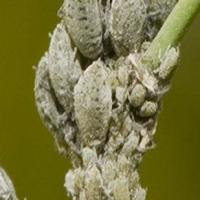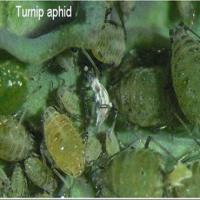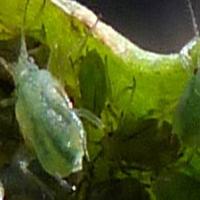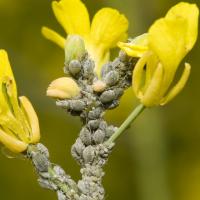Diagnosing canola aphids
Small soft-bodied winged (adults only) or wingless insects that damage canola by direct feeding or as a viral disease carrier.
What to look for
- Infestations can be in hotspots or spread throughout the paddock.
Plant
- Water-stressed seedlings with aphids on the growing point or leaf underside.
- Aphid clusters on buds and flowers that result in flower abortion.
Plant
- Cabbage aphids form dense bluish grey colonies covered with fine whitish powder on flowering heads in spring. They also establish on crowns and under leaves in the vegetative phase. Infestations are usually as 'hotspots' in the paddock. The adult aphid is dull or greyish-green.
- Turnip aphids infest individual plants in a similar way, but plants are more uniformly infested throughout the paddock. Aphids have a waxy coating, which is not as pronounced as the powdery cover of the cabbage aphid. Adults are yellow to greyish green, sometimes with dark bars on the abdomen.
- Green peach aphids occur on the underside of canola leaves of young plants and are evenly distributed in the paddock. They transmit canola viruses, particularly beet western yellows (syn turnip yellows) virus, which can reduce yield with early infection. The aphid is shiny yellow to mid-green, pink or red with a black patch on the abdomen of adults.
Insect Adult
Where did it come from?

Alternate host
- Aphids have numerous generations throughout the year and survive the off season on alternative hosts.
Management strategies

Spraying insecticide
- Yield loss is most likely at bud formation to flowering when: 20% or more plants are infested with aphids; Also dry weather reduces yield potential.
- Border sprays under these conditions can sometimes be justified for cabbage aphid, which can colonise heavily around the perimeters of crops.
- In high to medium rainfall areas canola crops have the ability to recover from aphid infestations that occur during flowering. Canola grown in low rainfall areas is less likely to compensate for aphid damage.
- There is no yield loss if aphids colonise crops that have finished flowering and are at the podding stage.
How can it be monitored?
- Check crops for aphids at flowering.
Further information
Page last updated: Monday, 1 May 2017 - 12:07pm






